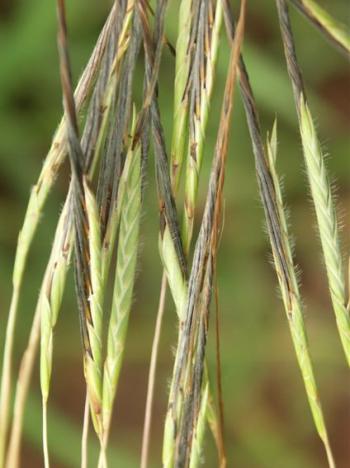Heteropogon contortus
Heteropogon contortus (L.) Roem. & Schult.
Family: Poaceae
Common names: tanglehead, spear grass (Eng.); pylgras, assegaaigras (Afr.); isitupe (IsiZulu); makurwane (Setswana); selokana, seloka (Sesotho)
Introduction
A hardy grass that is very attractive and palatable in the early vegetative stages, but becomes less attractive and unpalatable as it matures.

Description
Description
Heteropogon contortus is a rhizomatous perennial, growing from 200 to 1 000 mm high. The greenish grey leaves are usually glabrous or with few hairs. Leaf blade is 30–300 × 3–8 mm, usually folded, with rounded and often hooded apex. Ligules are membranous.

Inflorescences are single, spike-like racemes, with awns appearing to be velvet-like only in the upper half. It has glandless spathes.

Sessile (stalked) spikelet is 5.5–7.0 mm long. The pedicelled (unstalked) spikelet is 8–13 mm long and is glandless. The anther is 3.0–3.5 mm long. The tangle head produces white flowers, and it flowers in summer, from October to June.
Conservation Status
Status
According to the Red List of South African plants, Heteropogon contortus is not threatened, and is listed as Least Concern (LC).
Distribution and habitat
Distribution description
Heteropogon contortus prefers tropical and warm temperate regions around the world. It is very widespread in South Africa, occurring in the North-West, Limpopo, Mpumalanga, Gauteng, KwaZulu-Natal, Eastern Cape and the Western and Northern Cape. It also occurs in Namibia, Botswana, Swaziland and Lesotho.
This species thrives on poor soils. However, it prefers growing in sandy to clayey loam, well-drained soils, usually on hillsides and among rocks. It is resistant to grass fires.

Derivation of name and historical aspects
History
The name Heteropogon is derived from the Greek words heteros, meaning ‘different’ and pogon, meaning ‘beard’, in reference to the male spikelet being awnless and the female spikelet being awned. The specific epithet contortus, means ‘tangled’ or ‘twisted’.
The genus Heteropogon is quite small, with ± 6 species in tropical and subtropical regions. Only 2 species are found in southern Africa, namely, H. contortus and H. melanocarpus.

Ecology
Ecology
Like most grass species, the seeds of Heteropogon concortus are dispersed by wind. Animals and humans also aid in the dispersal of seeds when attached by the sharp-pointed tips of the seeds.
Uses
Use
Spear grass has been introduced into many parts of the world as a forage grass. After flowering, the sharp-pointed seeds and tangled awns penetrate the woolly coats of sheep, reducing the value of wool. They also cause infections or severe injuries to animals, by piercing through the skin and then into their body cavities. Therefore, it is best grazed or cut for hay or silage early in the summer, when the grasses are still young. Other uses include thatching of huts, weaving mats and control of erosion.
Growing Heteropogon contortus
Grow
Spear grass often grows naturally in Savanna grasslands. Seasonal fire disturbances play a vital role in clearing up an area (removing competition), for the establishment of seedlings. The twisted awns and the sharp pointed tips of the seeds assist in seed burial in the soil surface. H. contortus grows in areas of lower fertility, fixes its own nitrogen and it does not require much water. Companion grasses include Themeda triandra and Schizachyrium sanguineum. It is rarely sown, but can be propagated from seeds or stem cutting.
When cultivated, store fresh seeds for 6–12 months before sowing, as they are still dormant. Seed cleaning is difficult because of the presence of the awn and callus. Sow seed in no deeper than 1 cm, in a seedbed. The most favorable temperature for seed germination ranges between 30 and 35°C. The plant should be planted in a sunny position and on well-drained soils. It does not require much additional fertilizers, but can be fed with small applications of foliar feeds.
Vegetatively, use splits of mature plants. Adequate levels of temperature and soil moisture initiates growth, and is facilitated by significant rainfall.
References
- Fish, L., Mashau, A.C., Moeaha, M.J. & Nembudani, M.T. 2015. Identification guide to southern African grasses. Strelitzia 36: 271–276. South African National Biodiversity Institute, Pretoria.
- Fish, L. & Victor, J.E. 2005. Heteropogon contortus (L.) Roem. & Schult. National Assessment: Red List of South African plants version 2017.1. Accessed on 2017/04/26.
- Tropical Forages. Forages Factsheets. Heteropogon contortus. http://www.tropicalforages.info/key/Forages/Media/Html/Heteropogon_contortus.htm Accessed: 2017/04/26.
Credits
Cynthia Mikateko Baloyi and Aluoneswi Caroline Mashau
Pretoria National Herbarium
May 2016
Plant Attributes:
Plant Type: Grass
SA Distribution: Eastern Cape, Free State, Gauteng, KwaZulu-Natal, Limpopo, Mpumalanga, North West, Northern Cape, Western Cape
Soil type: Sandy, Clay, Loam
Flowering season: Early Summer, Late Summer, Autumn
PH: Acid, Alkaline, Neutral
Flower colour:
Aspect: Full Sun
Gardening skill: Easy
Special Features:
Horticultural zones









Rate this article
Article well written and informative
Rate this plant
Is this an interesting plant?
Login to add your Comment
Back to topNot registered yet? Click here to register.